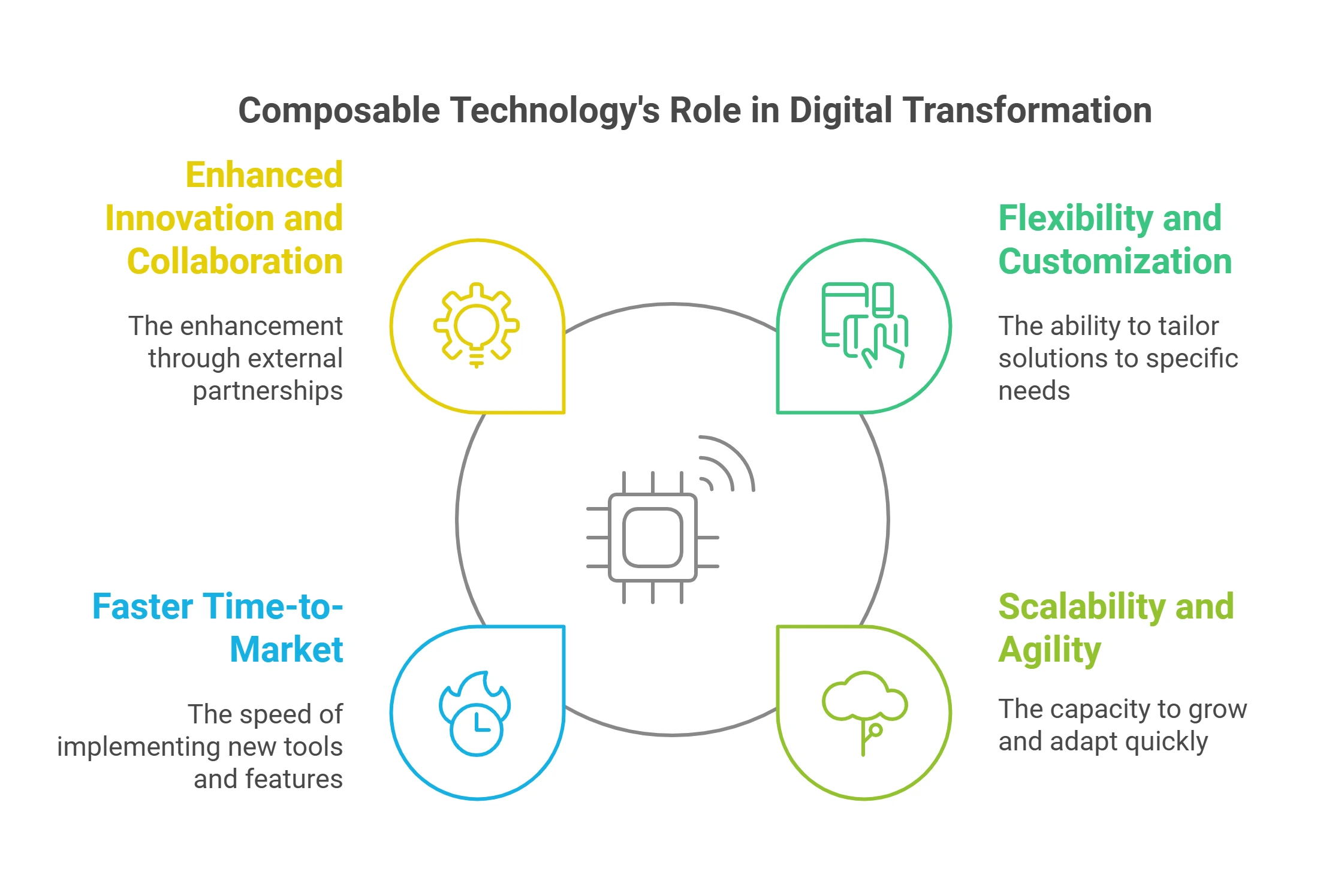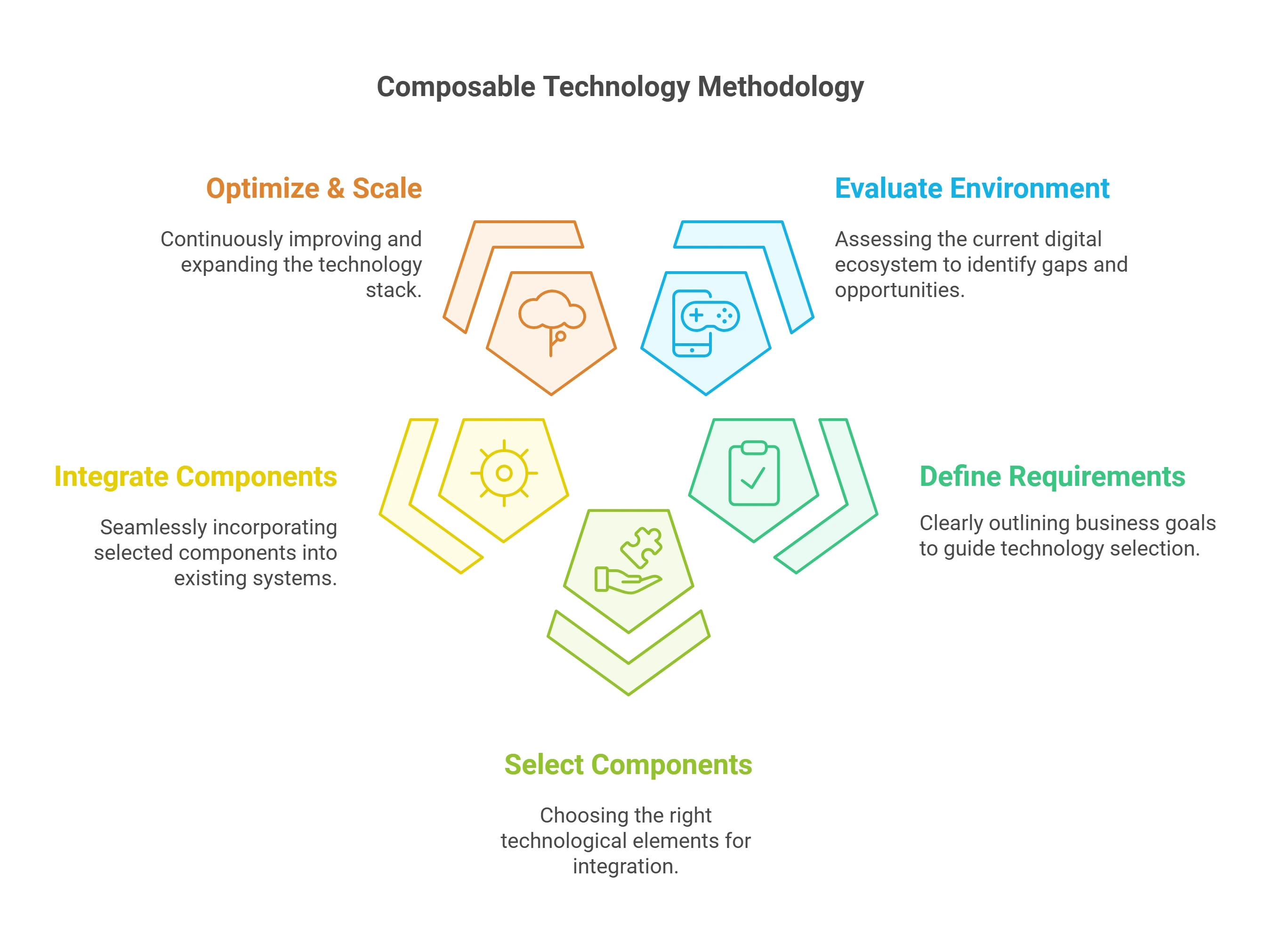How to Use Composable Technology for Seamless Digital Transformation

In the contemporary, swiftly changing business environment, organizations are always pursuing methods to optimize their operations, enhance efficiency, and maintain a competitive edge. Digital transformation has emerged as a pivotal factor in attaining these objectives. Many firms encounter difficulties in establishing conventional monolithic systems that are frequently rigid and expensive. Composable technology offers a flexible, scalable, and adaptable foundation that enables enterprises to expedite their digital transformation process.
This article will examine the utilization of composable technology for effective digital transformation and its significance as a transformative factor in the B2B technology landscape.
What is Composable Technology?
Composable technology is a methodology in digital architecture that enables enterprises to construct and integrate applications and solutions from a set of loosely connected, interoperable components. These elements, also known as "microservices," are autonomously generated, deployed, and scaled, enabling companies to choose and configure only the essential components that align with their particular requirements.
Composable technology allows businesses to select optimal tools and services rather than depending on a uniform solution, providing flexibility, agility, and the capacity to swiftly adjust to evolving business needs.
The Role of Composable Technology in Digital Transformation

Digital transformation encompasses more than just technology; it involves re-evaluating a company's operational methods and the value it provides to its consumers. Composable technology is important in this change, allowing firms to develop customized solutions that address their specific requirements. Composable technology enables digital transformation in the following manner:
- Flexibility and Customization
Conventional legacy systems frequently possess inflexible frameworks and restricted opportunities for personalization. Composable technology enables firms to customize components according to their distinct requirements. Composable technology allows firms to develop highly tailored solutions by incorporating new e-commerce platforms, connecting CRM systems, or upgrading AI-driven analytics tools, all without the need to begin anew. - Scalability and Agility
Composable technology enables enterprises to rapidly and effortlessly scale their digital infrastructures. As your enterprise expands, you can incorporate new elements or enhance old ones without disturbing your entire system. This adaptability enables firms to adjust to market fluctuations, client requirements, or technical innovations with minimal resistance. - Faster Time-to-Market
Digital transformation frequently necessitates the swift implementation of novel tools and functionalities. Composable technology expedites this process by offering pre-constructed, standardized components that may be swiftly incorporated into existing systems. This minimizes the time and effort required to create bespoke solutions from the ground up, enabling enterprises to innovate more rapidly and maintain a competitive edge. - Enhanced Innovation and Collaboration
Utilizing composable technology enables enterprises to leverage the most recent technologies and solutions present in the marketplace. This promotes innovation and collaboration with external partners, enabling organizations to seamlessly incorporate third-party products into their ecosystem. Furthermore, the modular characteristics of composable systems allow enterprises to experiment and refine, resulting in ongoing enhancement and innovation.
Steps to Use Composable Technology for Seamless Digital Transformation

To effectively utilize composable technology for digital transformation, enterprises should adopt a systematic methodology. The following are the essential steps to commence:
Step 1: Evaluate Your Existing Digital Environment
Prior to deploying composable technology, it is crucial to comprehend your existing digital ecosystem. Evaluate your current systems, pinpoint deficiencies, and determine where composable technology might deliver optimal benefits. Evaluate elements including integration requirements, scalability, user experience, and customer expectations.
Step 2: Define Your Business Requirements
Explicitly delineate your business aims and objectives to ascertain which elements will most effectively fulfill your requirements. Are you seeking to improve consumer engagement via a more tailored experience? Do you require a more sophisticated data analytics system to enhance decision-making? Establishing these criteria will assist you in selecting the appropriate components for your composable technological stack.
Step 3: Select the Right Components
Composable technology offers a wide selection of components, such as microservices, cloud platforms, APIs, and pre-constructed solutions. Among the most often utilized composable components are:
- Content Management Systems (CMS): These systems enable enterprises to administer digital content across many channels and platforms.
- Customer Relationship Management (CRM): A CRM facilitates the management of customer interactions, monitors sales, and enhances customer satisfaction.
- Enterprise Resource Planning (ERP): ERPs facilitate the management of essential corporate processes, including finance, human resources, and supply chain operations.
- E-Commerce Platforms: These systems assist enterprises in overseeing online transactions and consumer engagements.
- Data Analytics: Data analytics solutions offer insights into consumer behavior, sales performance, and other critical variables.
Choosing the appropriate combination of components is essential for ensuring seamless integration and attaining your intended results.
Step 4: Integrate and Customize Components
After selecting the components, it is time to incorporate them into your existing infrastructure. Given that composable technology emphasizes modular and interchangeable components, this phase should be rather uncomplicated. Nonetheless, integration may necessitate technical proficiency to guarantee seamless communication between systems.
Moreover, numerous composable components provide considerable customization capabilities. You can customize the appearance, experience, and functionality of the tools to conform to your business processes and branding.
Step 5: Optimize and Scale
Digital transformation constitutes a continuous process. Subsequent to the implementation of your composable technology stack, persistently assess its performance and optimize as necessary. Seek chances to enhance certain components, integrate new functionalities, or improve user experiences in response to feedback and changing business requirements.
Composable solutions provide intrinsic flexibility, allowing for seamless adjustments and expansions of your digital environment without interfering with existing systems. This guarantees that your digital transformation trajectory is consistent with corporate expansion and market dynamics.
Step 6: Cultivate a Culture of Ongoing Enhancement
Digital transformation is not a singular initiative; it is a sustained strategy. Foster a culture of perpetual enhancement, utilizing feedback from employees, customers, and stakeholders to propel innovation and refinement. Consistently assess the efficacy of your composable technology solutions and implement modifications as necessary to sustain a competitive advantage.
Best Practices for Implementing Composable Technology
Although composable technology provides significant advantages, its deployment necessitates meticulous design and execution. Presented below are few optimal techniques to contemplate:
- Prioritize Data Security: Guarantee that data safety and privacy are paramount in your deployment of composable technologies. Utilize secure APIs, encrypted connections, and stringent authentication protocols.
- Guarantee Cohesive Integration: Integration is essential for a successful implementation of composable technology. Select components that are compatible with your current systems and can be seamlessly integrated.
- Focus on User Experience: The user experience, encompassing both employees and customers, must be central to your digital transformation strategy. Ensure that the components you choose facilitate a cohesive and immersive experience.
- Collaborate with Experts: Utilize the knowledge of external suppliers, consultants, and technology partners to maximize the benefits of composable technology. These specialists can offer significant insights and assist in optimizing your deployment.
Summary
Composable technology is transforming the manner in which enterprises undertake digital transformation. Composable technology helps enterprises to develop flexible, scalable, and tailored solutions, enabling them to remain competitive, adapt rapidly, and address evolving client expectations.
By adhering to the aforementioned processes and using best practices, enterprises may leverage composable technology to facilitate a cohesive digital transition that corresponds with their distinct objectives, enhances operational efficiency, and propels growth. Utilizing the appropriate strategy, composable technology can be important in realizing the complete potential of your digital ecosystem.

